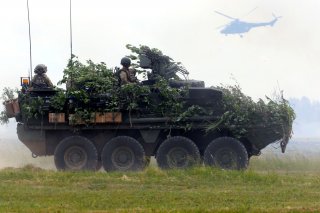The Army’s Brigade Combat Teams Will Get a Weapons Upgrade
Stryker Brigades can now effectively destroy enemy drones, helicopters and even some lower-flying fixed-wing aircraft, a weapons adaptation, which massively propels the combat-tested platform more fully into the well-known great-power competition era.
The Army is now stepping up efforts to arm its Brigade Combat Teams with Hellfire- and Stinger missile-equipped Stryker vehicles as part of a longer-term developmental trajectory intended to bring new dimensions to the services’ Short Range Air Defense technologies.
Stryker Brigades can now effectively destroy enemy drones, helicopters and even some lower-flying fixed-wing aircraft, a weapons adaptation, which massively propels the combat-tested platform more fully into the well-known great-power competition era.
Underway now for several years, the Army’s IM-SHORAD program is now gaining more momentum following years of successful testing and development. The Army has just awarded General Dynamics Land Systems a $1.2 billion contract to “produce, test and deliver interim SHORAD vehicles to the Army,” a statement from GDLS reported.
Air-defense weapons on the Stryker address a previously absent “counter-air” combat potential for Stryker vehicles. Senior Army weapons developers explain it this way; during the Cold War when the United States faced a Soviet threat, ground-launched air-defense was naturally a huge priority, something which “atrophied” during fifteen years of counterinsurgency.
Compared to an existing M2 .50-cal machine gun mounted on Strykers, the new thirty-millimeter weapon is designed to improve both range and lethality for the vehicle. The new gun can fire at least twice as far as a .50 caliber, General Dynamics Land Systems developers told the National Interest.
As a result, ground infantry supported by armored vehicles will need mobile air-defenses to address closer-in air threats. This is where the Stryker SHORAD comes in; infantry does not have the same fires or ground mobility as an armored Stryker, and handheld anti-aircraft weapons such as a Stinger would not have the same defensive impact as a Hellfire or Stinger-armed Stryker. In a large mechanized engagement, advancing infantry needs fortified armored support able to cross bridges and maneuver alongside foot soldiers.
Chinese or Russian helicopters and drones, for instance, are armed with rockets, missiles and small arms fire. A concept with SHORAD would be to engage and hit these kinds of threats prior to or alongside any enemy attack. SHORAD brings an armored, mobile air-defense in real-time, in a way that most larger, less-mobile ground missiles cannot. The Patriot surface-to-air missile, for instance, is better suited to hit incoming mid-range ballistic missiles and other attacking threats. While mobile, a Patriot missile might have less of an ability to support infantry by attacking fast-moving enemy helicopters and drones.
An emphasis upon “deployability,” “mobility” and “expeditionary” warfare maneuvers are indispensable to the Army’s Stryker deployment strategy. Along these lines, a recent essay from The Modern War Institute at West Point raises the point that Russia has an extensive and very evolved railway system - which enables much faster and larger deployment potential. Stryker Brigades able to move long distances at sixty miles per hour can offer a countermeasure or equivalent to rapid Russian mobilization. Demonstrating this mobility was a primary focus of the Army’s Dragoon Ride several years ago wherein Army Stryker units conducted extensive convoy movements across Eastern Europe while conducting interoperability exercises with NATO allies.
As part of an effort to further strengthen the Stryker for major combat, the Army is also now arming the Stryke with a vertical-take-off, turret-launched surveillance drone Shrike 2 and also preparing a 5kw laser weapon. The laser weapon system uses its own Ku-band tracking radar to autonomously acquire targets in the event that other sensors on the vehicle are disabled in combat, industry and military weapons developers explain. Lasers can also enable silent defense and attack, something which provides a substantial tactical advantage as it can afford Stryker vehicles the opportunity to conduct combat missions without giving away their position.
Kris Osborn is the defense editor for the National Interest. Osborn previously served at the Pentagon as a Highly Qualified Expert with the Office of the Assistant Secretary of the Army—Acquisition, Logistics & Technology. Osborn has also worked as an anchor and on-air military specialist at national TV networks. He has appeared as a guest military expert on Fox News, MSNBC, The Military Channel, and The History Channel. He also has a Masters Degree in Comparative Literature from Columbia University.
Image: Reuters

